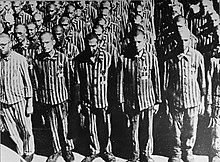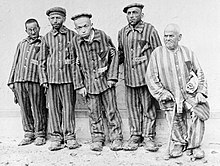Nazi concentration camp badge
Nazi concentration camp badges, primarily triangles, were part of the system of identification in Nazi camps. They were used in the concentration camps in the Nazi-occupied countries to identify the reason the prisoners had been placed there. [1] The triangles were made of fabric and were sewn on jackets and shirts of the prisoners. These mandatory badges of shame had specific meanings indicated by their color and shape.
Badge coding system



The system of badges varied between the camps, and in the later stages of the war, the use of badges dwindled in some camps, and became increasingly accidental in others. The following description is based on the badge coding system used before and during the early stages of the war in the Dachau concentration camp, which had one of the more elaborate coding systems.
Shape was chosen by analogy with the common triangular road hazard signs in Germany that denote warnings to motorists. Here, a triangle is called inverted because its base is up while one of its angles points down.
Single triangles
- Red triangle—political prisoners: communists, trade unionists, liberals, social democrats, Freemasons, anarchists.
- Green triangle— "habitual criminals" (convicts, ofttimes Kapos, serving in exchange for reduced sentences or parole).
- Blue triangle—foreign forced laborers, emigrants.
- Pink triangle—sexual offenders which included homosexual men along with rapists, bestiality and paedophiles.[2]
- Purple triangle—"Bible Students" (Jehovah's Witnesses).
- Black triangle—people who were deemed "asocial elements" and "work shy" including
- Roma (Gypsies), who were later assigned a brown triangle
- The mentally retarded
- The mentally ill
- Alcoholics
- Vagrants and beggars
- Pacifists
- Conscription resisters
- Prostitutes[3][4]
- Some anarchists.
- Brown triangle—Roma (Gypsies) (previously wore the black triangle).[5]
- Uninverted red triangle—an enemy POW, spy or a deserter.
It should be noted that people who wore the green and pink triangles were convicted in criminal courts and may have been transfered to the criminal prison systems after the camps were liberated.
Double triangles

Double-triangle badges resembled two superimposed triangles forming a Shield of David.
- Two superimposed yellow triangles, the "Yellow badge"—a Jew.
- Red inverted triangle superimposed upon a yellow one—a Jewish political prisoner.
- Green inverted triangle upon a yellow one—a Jewish "habitual criminal".
- Purple inverted triangle superimposed upon a yellow one—a Jehovah's Witness of Jewish descent.[6]
- Pink inverted triangle superimposed upon a yellow one—a Jewish sexual offender.
- Black triangle inverted triangle superimposed upon a yellow one—"asocial " and "work shy" Jews.
- Voided black inverted triangle superimposed over a yellow triangle—a Jew convicted of miscegenation and labeled as a "race defiler".
- Yellow triangle superimposed over a black inverted triangle—an Aryan (woman) convicted of miscegenation and labeled as a "race defiler".
Other badges

In addition to color-coding, some groups had to put letter insignia on their triangles to denote country of origin. Red triangle with a letter: "B" (Belgier, Belgians), "F" (Franzosen, French), "H" (Holländer, Dutch), "I" (Italiener, Italians), "J"[7] (Jugoslawen, Yugoslavs), "N" (Norweger, Norwegian), "P" (Polen, Poles), "S" (Republikanische Spanier, Republican Spanish) "T" (Tschechen, Czechs), "U" (Ungarn, Hungarians).[citation needed]
Also, repeated offenders would receive bars over their stars, a different color for a different crime.
- A political prisoner would have a red bar over his/her star or triangle
- A habitual criminal would have a green bar
- A foreign forced laborer would have a blue bar
- A Jehovah's Witness would have a purple bar
- A homosexual or sex offenders would have a pink bar
- An "asocial" would have a black bar
- A Roma (Gypsy) would have a brown bar
Many various markings and combinations existed. A prisoner would usually have at least two, and possibly more than six.
Some camps assigned Nacht und Nebel prisoners with two large letters, NN, in yellow.
Penal battalion, penal company, etc., are military units consisting of convicted persons for which military service was either the assigned punishment or a voluntary replacement of imprisonment.
Table of camp inmate markings
| Special markings |  Jewish race defiler |
 Female race defiler |
 Escape suspect |
Inmate number  Special inmates' brown armband |
 Applicable marks were worn in descending order as follows: inmate number, repeater bar, triangle or star, member of penal battalion, escape suspect. In this case, the inmate is a Jewish convict with multiple convictions, serving in a penal battalion, Strafkompanie, with extremely hard work and punishment. | ||
 Pole: "P" on a red triangle |
 Czech: "T" (the German word for Czech is Tscheche) on a red triangle |
 Member of the armed forces: red triangle, an enemy POW or a deserter. | |||||
Notes
- ^ Nazis Open Dachau Concentration Camp
- ^ Plant, The Pink Triangle.
- ^ Claudia Schoppmann: Nationalsozialistische Sexualpolitik und weibliche Homosexualität (Dissertation, FU Berlin, 1990.) Centaurus, Pfaffenweiler 1991 (revisited 2nd edition 1997). ISBN 3-89085-538-5
- ^ "Black triangle women" (html). 2001-02-01. Retrieved 2008-02-02.
- ^ Jewish Virtual Museum: Badges
- ^ Note that since "Jew" was defined along "racial" lines, e.g. by the Nuremberg Laws, Jews could be classified as Jehovah's Witnesses.
- ^ Politika: У Аушвицу, на вест о ослобођењу Београда
References
- Plant, Richard, The Pink Triangle: The Nazi War Against Homosexuals, Owl Books, 1988, ISBN 0-8050-0600-1.
- Camp badge chart at historyplace.com
External links
- United States Holocaust Memorial Museum Classification system in Nazi concentration camps.
- Stars, triangles and markings - Jewish Virtual Library
- Gay Prisoners in Concentration Camps as Compared with Jehovah's Witnesses and Political Prisoners by Ruediger Lautmann




























